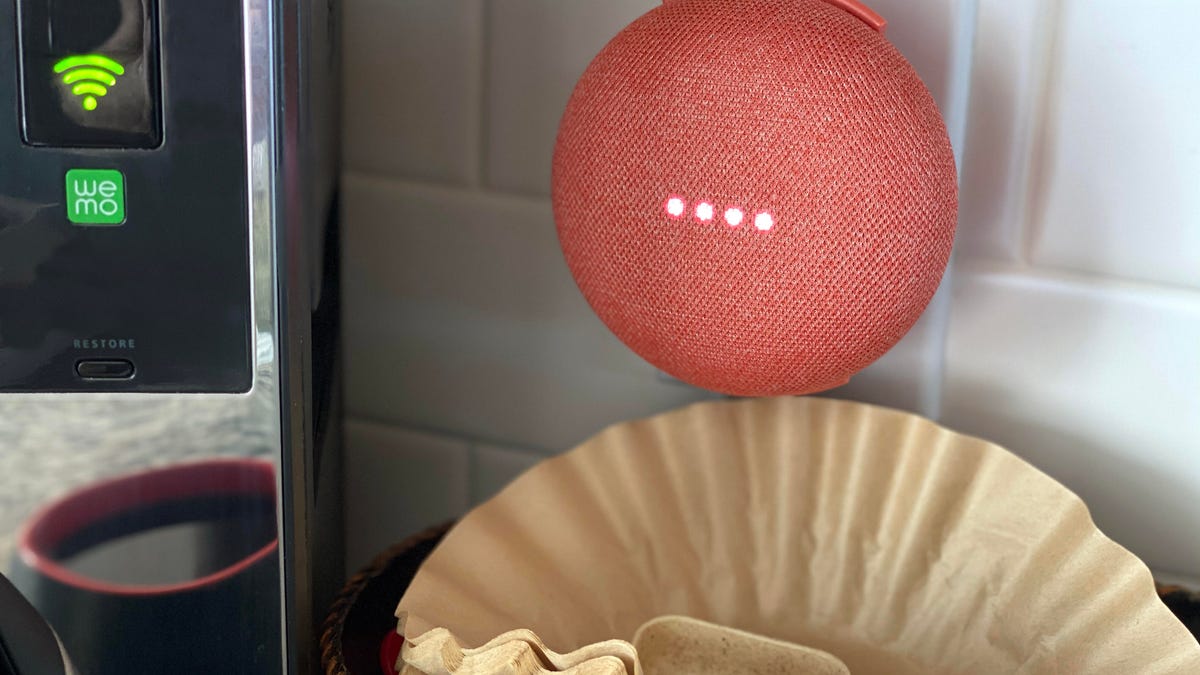8.2
Mill kitchen bin
Like
Grinds most kitchen scraps into odorless dirt
Makes very little noise
Cut my kitchen waste by more than half
Meant to ease two environmental burdens: food waste and factory farming
Has a sleek, minimalist look
Cheaper than most private curbside compost services
Don’t like
Expensive monthly subscription
Company is not yet using material for chicken feed -Other bins turns scraps into something closer to compost
No matter how vigilant we are against food waste, unless we’re composting regularly — be it by choice or municipal mandate — we’re sending to landfills untold amounts of organic waste that could be used elsewhere. But even composting may not be the most environmentally sound way to deal with spoiled produce, cast-off fish skin and leftover chicken marsala.
The Mill kitchen bin system hopes to make more out of your kitchen scraps than just compost.
A new crop of kitchen composters and smart bins has emerged in the past few years. Each one aims to reduce the amount of kitchen scraps that end up in household trash cans and local landfills. The Mill bin is the latest and perhaps most ambitious at-home approach to food waste diversion.
And it’s definitely not a composter.
The Mill bin doesn’t make compost — and that’s OK
Mill doesn’t claim that its bin makes compost like its competitors — the Lomi, Vitamix FoodCycler and Reencle Prime among them — and that’s by design. In fact, Mill argues those machines can’t make compost that quickly either. Instead, Mill’s approach involves a closed-loop subscription service where apple cores, avocado pits and moldy bread are ground and dried inside a leased smart bin and sent back to be sold as an ingredient for making chicken feed.
Food scraps (left) and what the Mill bin turns them into during one six-hour cycle (right).
The novel system is meant to curb food waste in the home while also providing a sustainable source of livestock food that lessens the need for industrial farming. For context, growing food is a massive drag on the environment. It demands about 20% of US land and more than 30% of the energy we produce, according to a study by the University of California, Davis. An estimated 36% of food grown globally is used to feed livestock, as reported by National Geographic.
Read more: Nope, You Can’t Recycle Black Plastic Takeout Boxes. Here’s What You Can Recycle
Mill’s idea makes good sense, and the company has received favorable legal rulings and recommendations on its way to getting the bin’s output deemed suitable for use in chicken feed — it’s not used for making chicken feed, as of this writing.
I decided to see how the Mill bin worked in practice. Using the sleek smart bin was easy, and it cut my weekly household waste by at least half. It functions as efficiently as any smart home trash bin we’ve tested. But the bottom may fall out for some when you get to Mill’s payment plan.
Mill’s system is expensive compared with other kitchen waste solutions
Buying a Mill bin outright ($1,000) will cost you double that of a Lomi machine.
The Mill subscription costs $33 a month, or $396 per year, a recurring fee that includes free pickup of processed scraps and the use of the smart kitchen bin (with the subscription you don’t own the bin). The subscription also gets you free filter replacements (needed about every 60 days) and servicing, should anything go wrong. That cost is about the same as the price of a curbside composting program, and most of those don’t include a smart bin.
Mill just launched a nonsubscription model too, but it’s a budget-buster. The machine costs a whopping $1,000 to buy outright and includes a year of filters but doesn’t include material pickup.
How the Mill setup works: What you can and can’t process
Setting up the bin and a profile in the app took only a few minutes. The most laborious part was moving the bin around the kitchen, since it weighs 50 pounds.
I was pleasantly surprised to find that the Mill bin had pulverized these chicken bones in one grind-and-dry cycle.
I was surprised by the modest size of the part of the bin that holds scraps, compared with the entire appliance, which is about the size of most standard kitchen bins. But I realized after a few grinds that it was a nonissue. The Mill shrinks food by more than half, and it took me more than two weeks to fill it up even once.
There’s a list of food scraps that Mill recommends processing and others that are on a no-fly list — either because the Mill bin can’t process them without jamming or because the scraps would be compromised for animal feed.
Unusually oily food or food made up of too much sugar isn’t recommended for the bin. Dead houseplants, of which I have a steady supply, are also a no-go. The same goes for corn husks, mass amounts of potato peels and larger bones.
But still, the Mill handled more types of waste than I thought it would. The gears easily gobbled up large, dense avocado pits and took care of cooked chicken carcasses. It handled all the coffee grounds I threw in it and pulverized produce seeds and peels.
Mill’s kitchen bin turns food scraps into the base for chicken feed. While the feed is not currently being produced with the material, Mill has won a few favorable decisions and recommendations from the FDA and opther governing bodies.
The Mill bin starts grinding and dehydrating food at whatever time you tell it to via the mobile app. It takes about six hours to complete a cycle, so right before bed made the most sense for me. After a few audible and dog-startling grunts, the Mill eases into action and emits only a soft whirr for the remainder of the cycle.
In the morning, like magic, gnarly food scraps have been transformed into something that looks a lot like rich soil or compost. I disposed of shellfish, salmon skin, moldy bread and other classically smelly things in my Mill and never once awoke to an unpleasant odor.
The handy app tells you when it’s time to empty the contents of the Mill into a prepaid shipping box and schedule a pickup. It’s not hard to judge this on your own, though, in case you don’t want another mobile app telling you what to do.
My scheduled pickup didn’t happen, but I was able to get the box into the hands of a USPS driver the next day.
I couldn’t believe how many food scraps I was producing
It was revelatory to have a visual representation each day of how much food waste I produce that’s typically destined for the landfill. Hucking banana peels and stale crackers happens in small doses over a day or week, but boy does it add up quickly.
While I was using the Mill system, I marveled at how seldom I was taking out the trash. That also meant using fewer plastic garbage bags — another one of the brand’s big selling points.
What else can you do with the Mill material? Not much
Mill material isn’t a replacement for soil or fertilizer.
To test the processed food’s viability, I mixed some with planting soil, roughly half and half, and tried to rehouse an aloe plant. It died within a few days. As a reminder, Mill doesn’t claim the output is fit for nourishing plants. I was just hopeful, I guess.
On that subject, I spoke with someone about what can be done with Mill material if you choose not to send it back. Sally Brown is a research professor at the School of Environmental and Forest Sciences at the University of Washington and a self-proclaimed soil nerd. She told me that though dirt alone can’t support plants, it can be mixed with mature soil in your yard or garden, where it’ll continue to compost on its own and eventually deliver nutrients to the surrounding flora. Using a ratio of 1-to-10 (Mill dirt to soil) is recommended.
While Mill is very clear about its machine not making viable compost, it does give your food scraps a huge headstart if you plan to treat them and turn them into real compost on your own.
Mill material can also be safely scattered or diffused in most outdoor areas. Just don’t expect a bounty of wildflowers to spring up.
The Mill system is great… if you can afford it
The Mill bin looks nice and works extremely well.
The Mill bin as an appliance gets a near-perfect score, and on its face the concept is deeply admirable. Mill’s program is, in theory, a more powerful fix than most composting systems, since it addresses food waste and provides a sustainable source of food for livestock, which could curb carbon-heavy feed farming.
But the cost of Mill’s setup can’t be ignored. If you can swing the monthly dues, Mill aims to be a more comprehensive solution to food waste than most options. (Reminder: Chicken feed isn’t yet being made with the material.) But I couldn’t quite justify it, particularly when my city now offers a free, albeit stinkier, way to recycle food scraps at scale.
Your other options for kitchen scraps
Classic composting
Worm composting is another way to speed up the process of making fertilizer for your garden and house plants.
The cheapest fix for food waste is classic at-home composting, but it’s tricky to do and takes dedication and commitment. It’s also an odorous affair, particularly if you live in tight quarters or up several flights of stairs and can’t get the food waste outside immediately. Freezing food scraps until you can transport them to an outdoor pile helps. Here’s our guide to starting a compost pile and our step-by-step explainer on how to build a (surprisingly not gross) worm farm for composting.
Other curbside compost services
Other private compost pickup services exist, but most don’t include a smart bin. They’ll retrieve your kitchen waste every week to be reused or recycled in other ways. They typically cost anywhere from $25 to $40 a month, depending on where you live.
Cheaper smart kitchen bins and countertop composters
Lomi’s grow mode produces a material similar to Mill’s but without the high subscription cost.
All three of Mill’s competitors offer countertop models that are hundreds of dollars cheaper. The Lomi by Pela, which we tested in 2022, is $500 for the machine but can be had for as little as $300 on sale. Vitamix’s FoodCycler, one that we’re currently testing, starts at $400 for the base FC-50 model. The Lomi and FoodCycler also have recurring costs in the form of pads and filters. For Lomi, they’ll run you about $9 per month.
Reencle, which makes the boldest claims about turning food scraps into nutrient-rich fertilizer in two days using microbes that emulate the human digestive system, sells a composter that starts at $500. Dr. Brown, who works with Mill, told me you can’t really make true compost that quickly. We’re planning to test this model to see if it can.
The problem Mill aims to solve is too big for one appliance
With its closed-loop food scrap recycling system, Mill takes aim at both food waste and excessive factory farming for animal feed.
An estimated 30% to 40% of the food supply is wasted each year, according to the US Department of Agriculture. That’s more than 131 billion pounds of food that otherwise could be consumed. About 45% of that waste happens in the home, which is an awful lot but still leaves more than 50% that occurs in restaurants, retailers, supermarkets and on farms.
As with a number of other proposed solutions to sprawling environmental woes, Mill’s fix would be a drop in the bucket — but every drop helps. To make a real impact in positive waste diversion, Mill’s program would need to be adopted at scale. At $33 a month, that seems unlikely, but a large-scale government contract with the virtuous home tech brand might be a natural fit.
Is the Mill kitchen bin worth it?
As a decades-long city dweller, I’ve considered the curbing of kitchen waste to be a largely improbable notion. Though recent municipal composting mandates have been encouraging, including in Brooklyn, where I live.
With a free compost program available to me, I couldn’t justify the recurring cost for Mill. But if your budget allows or you were planning to pay for curbside recycling anyway, there’s no good reason not to tag into Mill’s smart food recycling system.
The chickens will love you for it.




